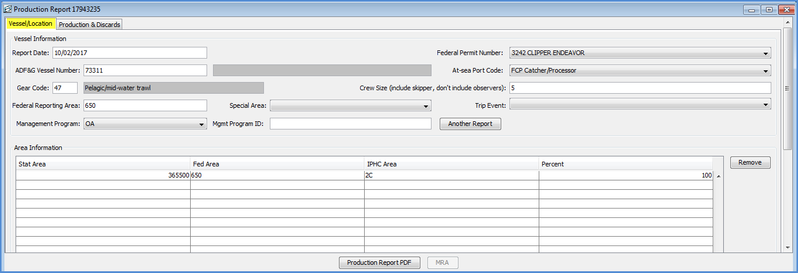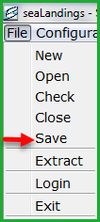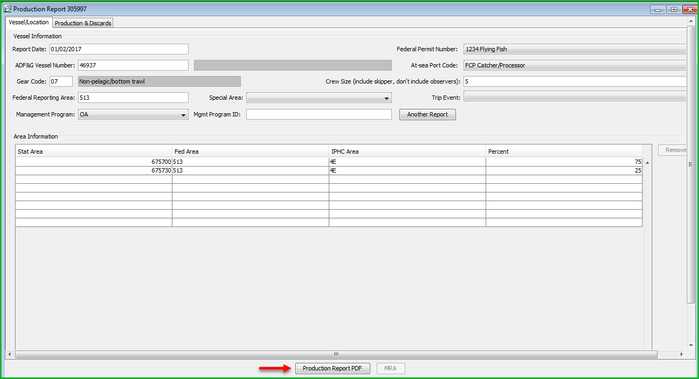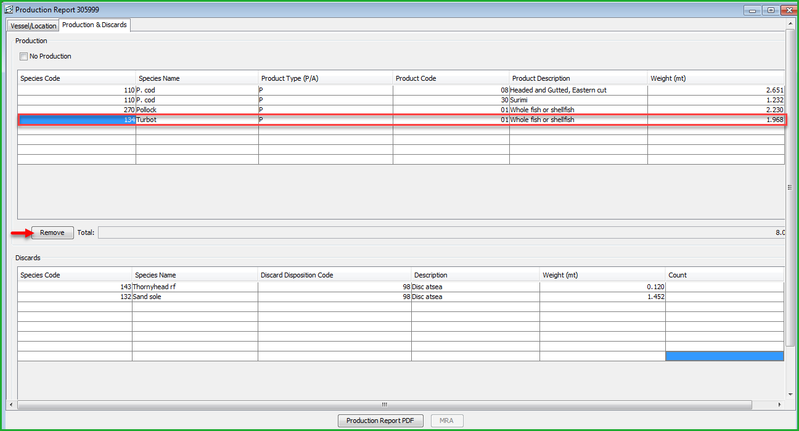eLandings User Manual
Daily Production Reports
Creating a Vessel Production Report
- Open seaLandings by double clicking on the 'seaLandings' icon on your desktop.
- Enter your UserID and Password and click on Ok. (Please contact your home office or eLandings User Support at eLandings@alaska.gov if you have forgotten your user ID or password.)
- Click on File...New
- Verify that your vessel is listed as the Operation and choose Production as the Type of Report from the drop down list.
- Click OK.
- A Production Report file will open where users can enter Vessel/Location and Production & Discards data.
Vessel/Location Information
Report Date
- Vessels must submit daily Production reports no later than 12:00 pm, Alaska Standard time to account for the previous days production.
Federal Permit Number and ADFG Vessel Number
- These values automatically fill in using data you supplied when you registered your operation.
- If these numbers are incorrect, please contact eLandings support elandings@alaska.gov to change the values in your operation settings.
At-Sea Port Code
- This value will auto-fill based on the information you provided when you registered your operation.
- FCP is the correct code for catcher processors.
- FLD is the correct code for motherships.
Gear
- Enter the 1-2 digit number code for the gear type.
- A list of all the gear codes can be found in Codes menu at the top of the seaLandings screen.
Gear Code | Gear Description |
|---|---|
7 | Non-pelagic / bottom trawl |
47 | Pelagic / mid-water trawl |
61 | Longline/Hook-and-Line |
91 | Pot |
Gear Modifier
- When using pot gear you will need to note if you are using hard pots or slinky pots.
Crew Size
- Enter the number of crew on the vessel.
- This number should include the skipper, but not observers on board.
Federal Reporting Area
- Enter the 3-digit federal reporting area (such as 610, 543).
Special Area
- If you are a vessel using trawl gear in the COBLZ (C. opilio bycatch limitation zone) or the RCKSA (Red king crab savings area) in the Bering Sea, use the drop-down list to pick the appropriate code.
- Choose the AISWW special area if you are fishing in the state-managed Aleutian Islands Pacific cod fishery, unless your catch is coming off a CDQ quota or unless you are fishing in a cod parallel fishery (inside 3 miles while a cod Federal fishery is open).
- Otherwise, leave this field blank.
Management Program
- The most common management programs for at-sea catcher processors can be found int he table below:
| Management Program Code | Description |
|---|---|
| A80 | Amendment 80 cooperatives, Amendment 80 limited access |
| AFA* | American Fisheries Act pollock (BSAI) |
| AIP | Aleutian Islands Pollock |
| CDQ* | Community Development Quota (BSAI) |
| EXP | Experimental (Scientific research permtis) |
| IFQ | Individual Fishing Quota |
| OA | Open Access (includes parallel fisheries) |
| RES | Research |
| RPP* | Rockfish Pilot Program (GOA) |
| SMPC | State Managed Pacific Cod |
AFA: Any AFA-listed vessel that targets pollock and uses pelagic trawl gear in the Bering Sea should mark AFA as the management program. * When you select this program, you must enter a Management Program ID.
A80: Vessels that participate in the Amendment 80 limited access or Amendment 80 cooperative fisheries should mark A80 as management program. A mothership that process fish from an Amendment 80 limited access vessel or an Amendment 80 coop should also mark A80 as management program. A mothership that processes fish from an open-access or CDQ vessel should mark OA or CDQ, respectively. If a vessel always fishes off an Amendment 80 quota, they should still mark A80 even when they fish in the Gulf of Alaska. An Amendment 80 vessel also should mark A80 whenever their bycatch comes off an Amendment 80 quota.
CDQ: Vessels fishing CDQ groundfish and crab quota. * When you select this program, you must enter a Management Program ID.
RPP: Vessels that fish off a Rockfish Pilot Program quota should selcect management program RPP. When their catch is not coming off a Rockfish Program quota, they should choose OA or another management program. * When you select this program, you must enter a Management Program ID.
SMPC: If a vessel fishes for cod in state waters, the crew should choose SMPC as management program.
- One exception is when their catch is coming off their CDQ quota, in which case they should mark CDQ as management program.
- SMPC should not be marked when a vessel is participating in the parallel fishery, even if that vessel is in state waters.
- SMPC should only be marked when Federal fisheries are closed.
- An example is when a vessel is fishing for state cod in the Aleutian Islands or Gulf of Alaska.
Note: You should report AISWW as Special Area when your vessel is fishing in the Aleutian Islands state waters for cod when the Federal fisheries are closed. AISWW should not be marked when fishing in parallel waters.
OA: When a vessel is fishing open access or in the parallel fishery, even if they are in state waters while participating in parallel fisheries. Parallel fishing is inside 3 miles under a Federal opening. A mothership that processes fish from an open-access vessel should mark OA.
Management Program ID
- You should only enter a management program ID if you selected AFA, CDQ, or RPP as the management program; otherwise, leave this field blank.
The values for AFA, CDQ, and RPP management program IDs are listed in the table below.
Management Program | Management Program ID | Description |
|---|---|---|
AFA | 200 | AFA Catcher/processors |
AFA | 300 | AFA Motherships |
CDQ | 51 | Aleutian Pribilof Island Community Development Association |
CDQ | 52 | Bristol Bay Economic Development Corporation |
CDQ | 53 | Central Bering Sea Fishermen's Association |
CDQ | 54 | Coastal Villages Region Fund |
CDQ | 55 | Norton Sound Economic Development Corporation |
CDQ | 56 | Yukon Delta Fisheries Development Association |
RPP | 401* | RPP Entry Level |
RPP | 402 | CGOA RPP CV Limited Access |
RPP | 403* | CGOA RPP CP Limited Access |
RPP | 404* | Opted Out |
RPP | 405 | Trident Offshore Rockfish Cooperative Association |
RPP | 406* | FCA Cooperative |
RPP | 407 | I.S.A. Rockfish Cooperative |
RPP | 408 | North Pacific Rockfish Cooperative |
RPP | 409 | OBSI Rockfish Cooperative |
RPP | 410 | Western Alaska Fisheries Rockfish Coop |
RPP | 411 | Star of Kodiak Rockfish Cooperative |
RPP | 412 | Best Use Cooperative |
| RPP | 416 | Global Rockfish Coop |
| RPP | 417 | Pacific Rockfish Coop |
- Rockfish Pilot Program Descriptions are applicable for 2017, and are subject to change in future years.
Trip Event
- The Trip Event field allows crews to designate if this report is the first of a new trip for Maximum Retainable Amount calculations.
- Below are the different Trip Events that crews can designate for their report.
- Enter SSL Protection Area: A new fishing trip is triggered for any fishing after entering a SSL protection area closed to directed fishing for Pacific cod or Atka mackerel at 679.22(a)(7)
 , (a)(7)(v), (a)(7)(vi), (a)(8)
, (a)(7)(v), (a)(7)(vi), (a)(8) (a)(8)(iv) and (a)(8)(v).
(a)(8)(iv) and (a)(8)(v).
- Leave SSL Protection Area: A new fishing trip is triggered for any fishing after departing a SSL protection area closed to directed fishing for Pacific cod or Atka mackerel at 679.22(a)(7)
 , (a)(7)(v), (a)(7)(vi), (a)(8)
, (a)(7)(v), (a)(7)(vi), (a)(8) (a)(8)(iv) and (a)(8)(v).
(a)(8)(iv) and (a)(8)(v).
- Directed Fishing Closure: A new fishing trip is triggered for any fishing in an area following a change in the directed fishing status for any species retained aboard the vessel.
- Offload Product: A new fishing trip is triggered for any fishing following the offload of fish or fish products.
Crews can create MRA spreadsheets for their reports but only after reports have been transmitted and receipts have been processed.
There are a few Trip Events that are automatically assigned to reports, including New Week and Gear Change.
- The Trip Event called New Week is assigned to all reports that fall on a Sunday, even if the user designates a different Trip Event for that report. New Week also is assigned to reports with a report date of December 31 and January 1.
- The Trip Event called Gear Change is assigned to a report if gear type changes from the previous report, even if the user designates a different Trip Event for that report. The user does not manually select the Trip Event of New Week and Gear Change; instead, these Trip Events are automatically assigned by seaLandings.
Statistical Area
- A six digit State statistical area is a required entry on production reports, except if you are submitting reports with "No Production" or "No Deliveries".
- You will need to enter the 3 digit Federal Reporting area in reports with "No Production" or "No Deliveries".
- Statistical areas can be found in the Codes link at the top of your seaLandings program.
- Place your cursor in an open field under the Stat Area heading, and enter a 6-digit statistical area.
- Tab past the next two fields, which will automatically fill in for you.
- Enter a percent for the amount of your catch that was hauled in this area.
- To delete a row, highlight any field in that row and click on the Remove button.
- If you fished in a different Federal reporting area during the same trip, you'll need to create a separate Production report.
Adding Production Data
Once you have completed entering information on the Vessel/Location tab, you can move on to the Production & Discards tab.
Species
- Enter a 3-digit species code. The Species Name will fill in automatically.
- Hit the tab or return key to move to the next field.
Product Type (P/A)
- Enter P for primary products and A for ancillary products.
- You may leave the P/A field blank and tab past this field because the field will automatically fill in when you tab to the next row.
- However, for ambiguous product codes that can be assigned as either P or A (such as fish meal), you are required to fill in the P or A code as it will not auto-fill when you tab to the next row.
Product Code/ Delivery Condition
- Enter a 1-2 digit product code. Product codes can be found in the codes menu at the top of the seaLandings screen. Product Descriptions will auto-fill.
- If you do not see an appropriate product code, use code 97. This requires the user to enter a comment describing the product derived from that particular species.
- As soon as you enter code 97, a Comment button will appear below the product table lines. Click on the comment button and then enter your description in the text box.
Weight (mt)
- All weights must be entered in metric tons to the nearest thousandth of a metric ton (such as 0.124 metric tons).
"No Production" Reports
- If you have no production for any day when you are checked in, then check the "No Production" check box.
- Only fill out a "No Production" report when you are (in theory) checked in.
- If you are (in theory) checked out you do not need fill out a daily production report.
Adding Discard Data
- Click into the first field of the discard section of the report.
Species
- Enter a 3-digit code for discarded species. The Species Name will auto-fill.
Disposition
- Enter a 2-digit disposition code. Disposition codes can be found in the Codes menu at the top of the seaLandings screen. Disposition Description will auto-fill.
Metric Tons & Number
- You may enter Metric Tons and/or Number for discards.
- Metric tons should be reported to the nearest thousandth (such as 0.123).
Save and Check for errors
- Save the production report by going to File...Save or by clicking on the disk icon, .
- To check for errors click on the icon, or go to File...Check.
- If there are any errors, a message screen will appear and list the errors that have occurred. You will not be able to transmit your report until all errors have been fixed.
Print the Production Report
- Once you have processed your return receipt, open your report by going to File...Open or click on the folder icon
- At the bottom of the production report screen, click on the Production Report PDF button.
- A dialog box will appear showing you that a .pdf file (named something like PR47805.PDF) is being saved in the seaLandings directory, C:\Program Files\seaLandings\pdf.
- Click Save.
The Adobe Reader window should automatically open the PDF so that you can print it.
- If Adobe does not open, use Windows Explorer and navigate to C:\Program Files\seaLandings\pdf.
- Open the production report and print.
Please be advised, regulations require you print and file paper copies of production reports and keep them on board the vessel for 3 years, including the current year.
Modifying Production Report Data
Editing Existing Reports
- Reports that have already been submitted may be edited at any time. However, all return receipts that correspond to that report first must be processed.
- The seaLandings system will not allow the user to edit a report for which a receipt has not yet been processed, and will display an error message.
- If you continue to try to make changes to the report without first processing the receipt, you'll receive an error message that states that "A report that has been sent by email cannot be updated until the return receipt has been processed."
- Click OK and close out of that report without saving changes.
- Then process the most recent receipt for that report.
To edit an existing report
- Go to File...Open.
- Double-click on the report that you wish to edit, or highlight it and click on the Open button.
- Make and save changes to that report.
- Then go to Reporting...Transmit Reports to transmit that report.
- Please email the transmission file to elecrep@noaa.gov.
- Remember, transmission files start with the word 'transmit' and are saved in the directory C:\program files\seaLandings\transmissions.
Submitting a report more than once does not duplicate data in NMFS' database! Instead, the edited version simply overwrites the existing version.
The only way to duplicate catch in NMFS' database is to create the same report more than once and to transmit more than one report with the same catch data.
Deleting Data
- To delete a row, click once on any field in that row. This should select the entire row.
- Then click on the Remove button.
Save the production report by going to File...Save or by clicking on the disk icon, .
Additional Reports
If you are reporting multiple areas, management programs, or management program IDs for the same day, you may click on the Another Report button to generate a duplicate report that will contain the same header information for the same week ending date (same date, permits, port code, gear code, crew size).
You must save your initial report before generating Another Report!
- When you click on the Another Report button, a second screen will open with the same date, permit numbers, crew size, gear code, and port code.
- You may change any of these fields, but you will likely receive a warning asking if you are sure about the change.
- Your initial report will remain open in the background.
- Enter the new Federal reporting area, special area, management program, management program ID (applicable only for CDQ, AFA, RPP), and State statistical area(s).
- Enter production and discard data and save your report.
- This can be done as many times as needed but keep in mind that production reports are to be submitted on a daily basis not all at the end of a trip.
Checking for Duplicate Reports
- If a production report already exists for the same day, gear type, port code, area, special area, management program, and management program ID, you will receive a warning message indicating that another report exists for that day with the same header information.
- This warning message is designed to discourage users from entering duplicate reports with duplicate catch data.
- You may still create duplicate reports with the same header information, but you will receive a warning before doing so.
Voiding/Deleting Duplicate Reports
- To delete reports that have already been submitted, please contact eLandings support elandings@alaska.gov with a list of report IDs that need to be deleted out of NMFS' database and justification for their deletion.
- Then you will need to delete the report on the user's end by going to C:\program files\seaLandings\reports, right-clicking on the duplicate report, and deleting it.
- It is the user's responsibility to check seaLandings for duplicate reports.
- Duplicate reports can mean doubling the catch in NMFS' catch accounting system.
Deleting a report on the user's end will not delete it on NMFS' end! You must contact eLandings support suja.hall@noaa.gov to remove the report from the database.
- Duplicate reports can mean doubling the catch in NMFS' catch accounting system.
Special Feature: Copy and paste data from Excel into seaLandings Production and Discard tables.
A user may enter their data in an Excel spreadsheet first and then copy and paste their data directly into the product and discard tables.
Below is an example of an Excel table of products that could be pasted into the product tables in seaLandings.
DO NOT COPY AND PASTE THE HEADER ROW.
| Species Code | Product Type (P/A) | Product Code | Weight (mt) |
|---|---|---|---|
| 110 | P | 8 | 9.346 |
| 270 | P | 7 | 2.612 |
| 110 | A | 35 | 0.102 |
| 124 | P | 7 | 0.105 |
Below is an example of an Excel table of discards that could be pasted into seaLandings.
| Species Code | Discard Disposition | Weight (mt) |
|---|---|---|
| 127 | 98 | .0087 |
| 191 | 98 | .0025 |
| 159 | 98 | .0057 |
- After you highlight the data in the excel spreadsheet, right click with your mouse and select Copy.
- Next, put your cursor in the first field of a new row of the product table and paste the data by holding down the Ctrl key with one finger while holding down the letter V with another finger.
- You will be able to see immediate results if done properly.

















